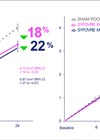The aim of this retrospective study is to assess the characteristics and natural history of quiescent CNV in geographic atrophy (GA) utilising multi-modal imaging. Case notes were reviewed of patients diagnosed with geographic atrophy between January 2010 and December 2016 at two major centres, who were followed-up for a minimum of 24 months. All patients underwent visual acuity testing, slit-lamp examination, dilated fundoscopy, fluorescein angiography (FA), indocyanine green angiography (ICGA), as well as optical coherence tomography (SD-OCT) and OCT-A when available. Progression of CNV was also analysed by review of autofluorescent images (FAF). Measurements of subfoveal choroidal thickness (CT), maximal horizontal diameter (MHD) and central macular thickness (CMT) were taken by two readers at baseline and at the last visit. Of 644 eyes (399 patients) with GA, only 73 eyes met the inclusion criteria (treatment naïve, quiescent CNV), of which 12 were excluded due to follow-up of less than 24 months, 12 developed exudation within six months of baseline and 30 had poor quality images. Therefore, only 19 eyes were analysed. During the follow-up period 74% (14/19 eyes) remained quiescent, with no signs of exudation. CT was slightly reduced, MHD significantly enlarged (708 microns at baseline and 1306 at last follow-up), and CMT was also slightly increased, with no intra-/subretinal fluid. Mean atrophy change was 5.08 mm2, with a lesion progression of 1.38 mm2/year; 26% of eyes developed exudation after a mean of 20 months and proceeded to anti-VGF treatment with ranibizumb. OCTA in these cases showed enlargement of the CNV as well as new vascular loops and capillaries. The authors point out that detection of quiescent CNV in GA can be harder, particularly if it is small in size and speculate whether OCT-A would make a valuable contribution. Based on previous molecular studies they hypothesise that this type of CNV could be protective, by preventing the development and further progression of atrophy, and should therefore only be treated if exudation occurs. They suggest a strict monitoring pattern for all such quiescent CNVs and recommend a classification of AMD into ‘exudative’, referring to CNVs with exudation, versus ‘neovascular’, referring to quiescent CNVs. They are aware of their study’s limitations, due to the small sample and its retrospective nature, and suggest further trials.
The natural history of treatment naïve choroidal neovascularisation (CNV) in geographic atrophy
Reviewed by Efrosini Papagiannuli
Treatment naïve quiescent choroidal neovascularisation in geographic atrophy secondary to non-exudative age-related macular degeneration.
CONTRIBUTOR
Efrosini Papagiannuli
Birmingham and Midland Eye Centre, Birmingham, UK
View Full Profile



